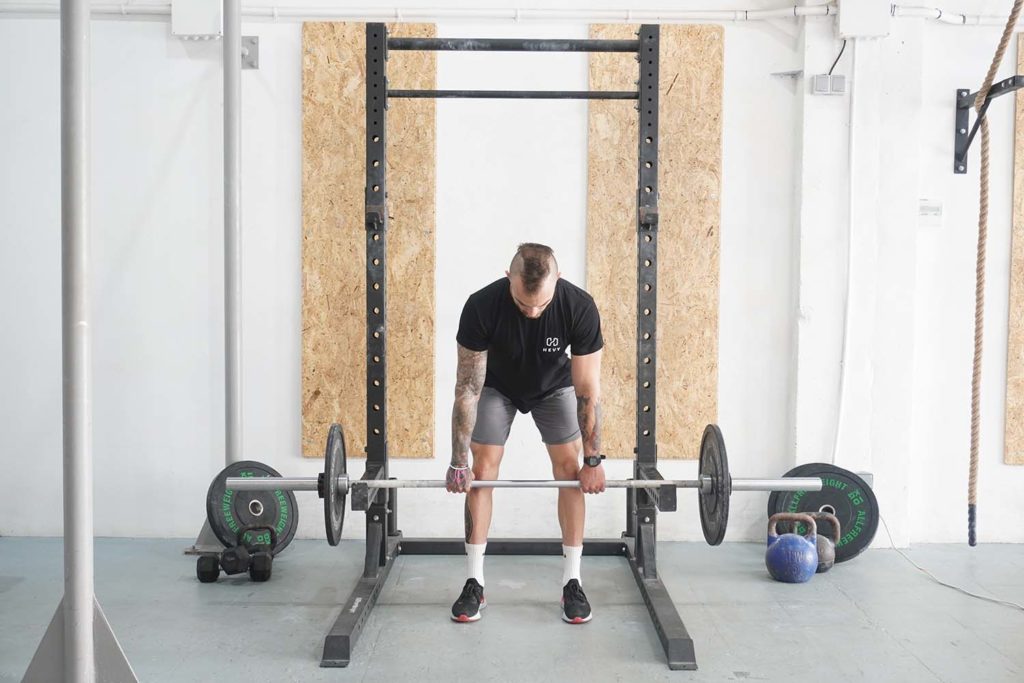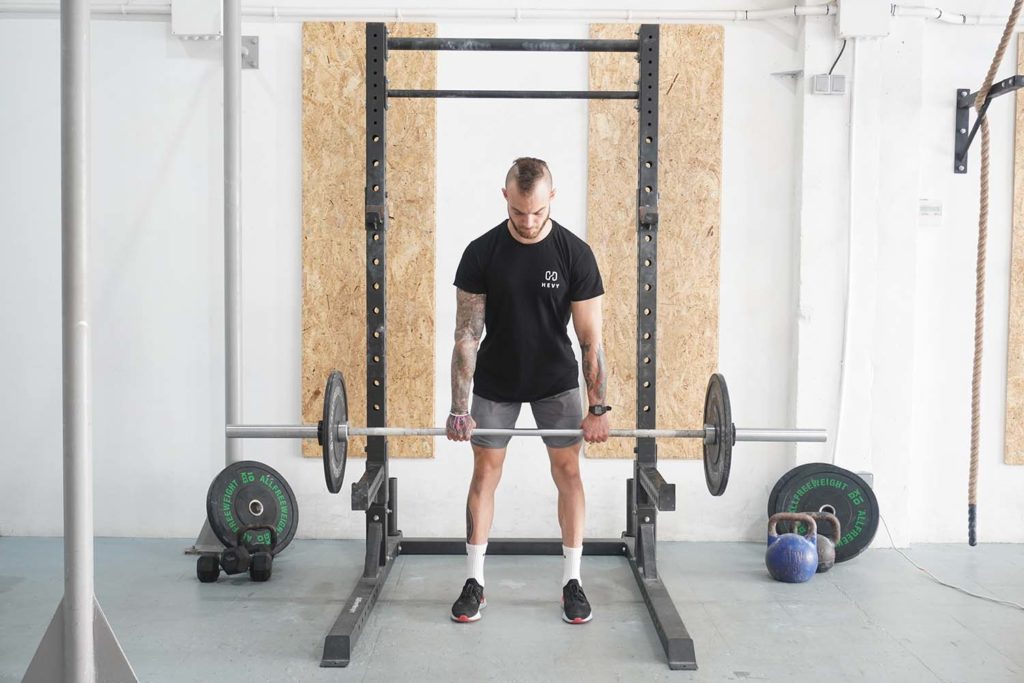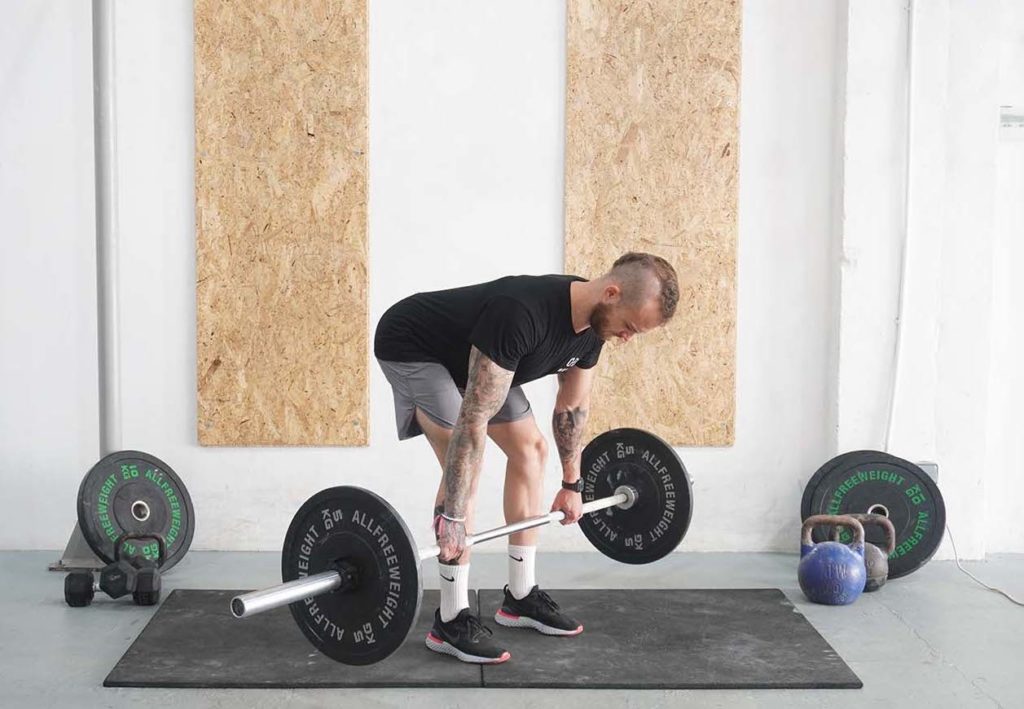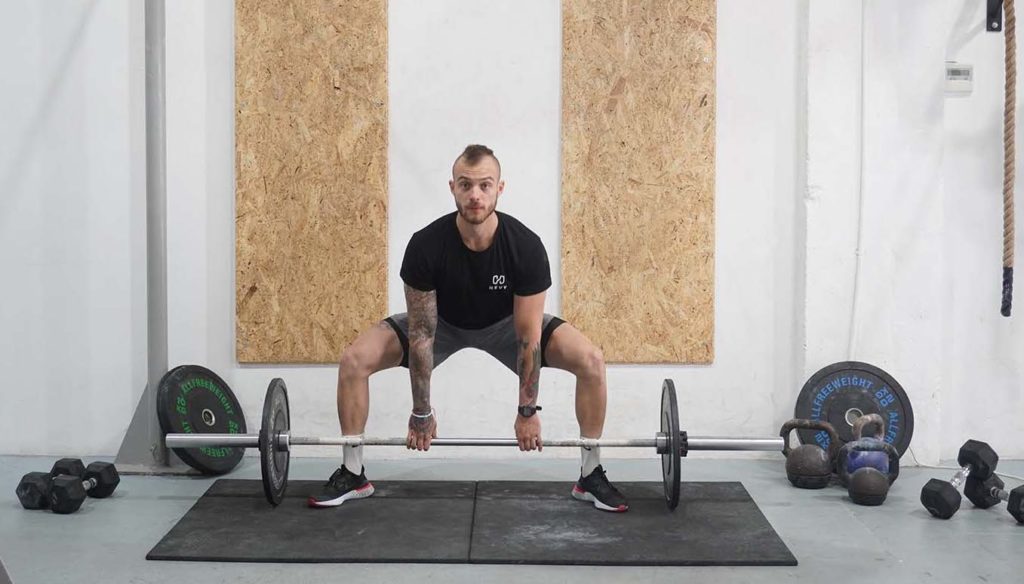Benefits of the Rack Pull
The rack pull is a movement that has you lift a barbell from an elevated position. Doing so allows you to practice the hip hinge pattern, strengthen your back, and improve your deadlift lockout strength. Since you’re not lifting the barbell off the floor, your legs aren’t as involved.
Rack pulls are one of the most straightforward and most efficient exercises you can use to build your back, improve your athleticism, and straighten your posture. Practicing the rack pull also builds grip strength, allowing you to perform many everyday tasks with ease: carrying groceries, picking things off the floor, and more.
How to do a Rack Pull
- Elevate a barbell on a rack (such as inside a squat rack) or blocks.
- Add weight plates to the barbell. The barbell should be an inch or two below knee level as you stand in front of it.
- As you position yourself to the barbell, your shins should be a couple of inches away from it.
- Bend forward and grab the barbell with an even overhand grip at shoulder-width distance. Doing so will place your shins against the barbell.
- Bring your chest out and bend your knees slightly. This maneuver will straighten your back and put your hips in the correct position for the lift.
- Engage your abs and take a breath.
- Pull the barbell in a straight vertical line by digging your heels into the floor and engaging your back.
- Lift the barbell until you’re upright and squeeze your glutes to lockout. Don’t hyperextend your lower back.
- Lower the barbell in the same straight line down, exhaling near the bottom. Keep your shoulders back as you lower the weight; don’t let the barbell fall.
What muscles does the rack pull activate?
The primary muscles involved in rack pulls are the ones in your back: erector spinae, latissimus dorsi, rhomboids (major and minor), and trapezius. All of them work hard to keep your spine neutral as you lift the barbell. Since rack pulls are a hip hinge movement, they also involve your hamstrings and glutes. Both muscle groups play an essential role in hip extension, allowing you to stand up with the weight.

Similarly, rack pulls also work your quadriceps to some degree. Your quadriceps produce knee extension, allowing you to straighten your legs at the top. Quadricep involvement depends on the height of the barbell’s starting position.
And finally, rack pulls are fantastic for training your forearms and grip strength. Your forearms work hard during the movement, and your grip strength improves since you’re forced to hold onto a heavyweight.
What is the difference between rack pulls and deadlifts?
Deadlifts and rack pulls are similar. Both are hip hinge movements that train your posterior chain and build your grip strength. The primary difference has to do with the weight’s starting position. With a classic deadlift, the barbell is on the floor, and you have to get into a lower position to pull it successfully. Your knees and hips are much more flexed. The deadlift is more challenging than rack pulls because the range of motion is much longer. Plus, getting into the correct deadlift starting position is more complicated than setting up for a rack pull.
Deadlifts are great for training your entire posterior chain and place more emphasis on your glutes and hamstrings than rack pulls do. The movement also trains your quadriceps more since your knees are much more flexed in the starting deadlift position.
Rack pulls represent the top half of a deadlift. In other words, you skip the initial pull off the floor and only move the barbell through the top half of the deadlift repetition. As a result, rack pulls emphasize your upper back more and involve your legs less. Plus, you can pull more weight, which is beneficial for your grip and deadlift lockout strength.
Variations and Modifications of Rack Pulls

1. Block Pull
Block pulls are the same as rack pulls. Instead of elevating the barbell inside a squat rack, the only difference is that you’re using blocks made of wood or something similar.
2. Above The Knee
This rack pull modification has you position the barbell above your knee. Doing so allows you to lift even more weight and further emphasize your upper back.
3. Trap Bar Rack Pull
Trap bar rack pulls are variations where you elevate a trap bar inside a rack or on blocks. Using a trap bar allows you to maintain a slightly more upright torso and emphasize your quadriceps better.
4. Resistance Band Rack/Block Pull
The banded rack pull is a variation where you wrap a resistance band over the barbell. Doing so lengthens the bands as you lift the bar, which progressively increases the resistance, peaking at the top.
Mistakes to Avoid
The most common mistake to look out for is using too much weight. Since the range of motion is shorter, people often use it as an excuse to add tons of weight and train their egos. But doing so only increases the risk of hitching the weight and getting injured.
The second common mistake with rack pulls is to allow the barbell to travel forward. Remember that rack pulls are a deadlift variation. As such, the barbell should remain against your legs throughout each repetition. If you create distance between the barbell and your thighs, you only make the movement unnecessarily more difficult and round your lower back.
The third mistake to watch out for is bouncing the barbell off the rack or blocks to do more repetitions. As you lower the weight, avoid slamming it into the rack for momentum. Sure, that allows you to lift a bit more weight, but it pulls the tension away from your muscles, which defeats the whole purpose of doing the exercise.
Similar Exercises to the Rack Pull
Conventional Deadlift

The conventional deadlift has the same movement pattern as the rack pull. The primary difference is, deadlifts have you lift the barbell off the floor, which lengthens the range of motion and forces your lower body to work harder.
Sumo Deadlift

Sumo deadlifts are similar to rack pulls because it is also a hip hinge movement that trains your posterior chain. But similar to conventional deadlifts, the sumo variation has you lift the barbell off the floor. The other difference is that sumo has you assume a wider stance, allowing slightly better adductor and quadricep involvement.
Trap Bar Deadlift
Similar to the previous two deadlift variations, trap bar deadlifts are another hip hinge movement that has you lift a weight off the floor. The primary difference is that trap bar deadlifts allow you to remain more upright, increasing quadricep involvement more than conventional deadlifts or rack pulls.
Reverse Hyperextension
Reverse hyperextensions are seemingly different from rack pulls. But both movements train many of the same muscle groups. Reverse hyperextensions train your hamstrings, glutes, and entire back, similar to rack pulls.
